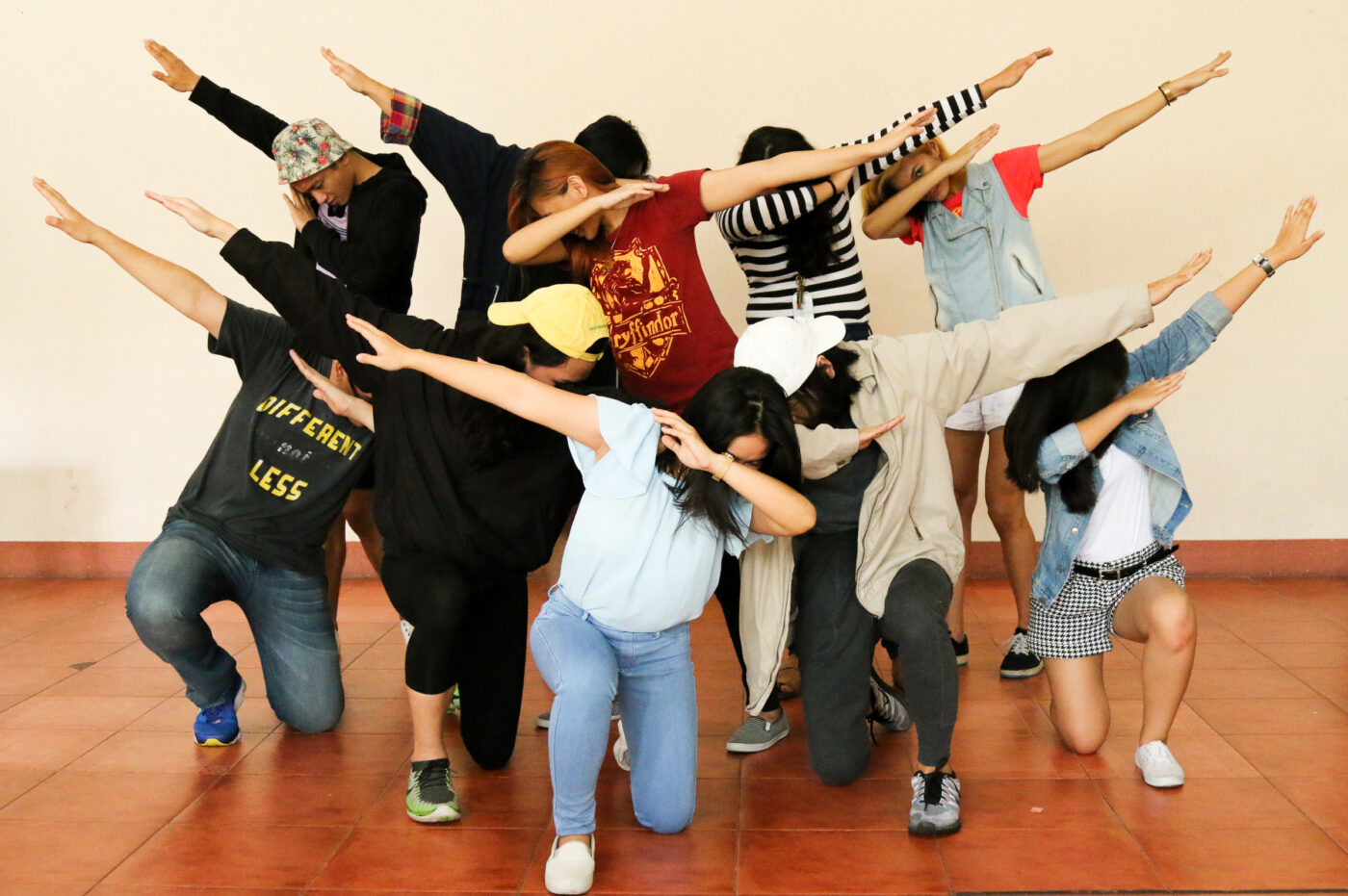Just as often as tropical cyclones grace the country, dance crazes come and go every year, taking the Philippines by storm and carrying dance cultures from all over the world.
Concert speakers thump some beats into the background. As beams of light sweep the stage and dry ice clouds the stage, the backdrop rolls away to reveal television show host Vice Ganda. A live audience cheers as he steps out into the limelight, beaming. “Whoops Kiri” by Fruitcake plays, and Vice Ganda and a crew of dancers get into their positions. They perform the dance sequence and moments later the entire studio is dancing along.
This is how local variety show ASAP panned out one Sunday in August 2013. Those who patronize shows like ASAP will find this scene quite familiar. Even before television personalities like Vice Ganda entered showbiz, dance crazes from earlier decades have already received nationwide attention.
Social media has also created a more conducive atmosphere for dance crazes to go viral. Lately, Filipinos have taken to Facebook, Instagram, and Twitter to post videos of themselves dancing to the contagious “Trumpets challenge,” also popularized by Vice Ganda. With the ever increasing and perennial popularity of dance crazes, it seems more and more likely that they will continue gaining traction in the Philippines over the next few decades.
Thriller throwback
Dance crazes didn’t just emerge in the contemporary period. According to sociology and anthropology professor Clarissa Mijares, Filipinos have historically been very “kinesthetically oriented.” She says that “Filipinos are quick to learn dance steps. Some of our folk dances are actually based on ‘dance crazes’ from Europe such as the Mazurka, Balse, Curacha, Polka, [and many others].”
In fact, we literally took dancing to court. The Surtido, which means “assortment” in Spanish, is a collection of popular court dances that fuse native and European dances. This is a showcase of how Filipinos could become enamored with foreign dances, blend them with some of our own, and create something entirely novel yet familiar out of it.
Even as we shifted into the modern period, the Filipino penchant for following the latest dance trends did not stop. Huge hits such as Janet Jackson’s “Rhythm Nation” and Michael Jackson’s plethora of singles from Thriller led to wildly successful crazes. We see here how dance trends are often catalyzed by the release of hits that caught on with mainstream pop culture.
Being a dancer herself, Mijares takes a trip down memory lane to recall the dance crazes of her time. “Having been born in the 80s, I was exposed to a lot of dance crazes. There was Madonna’s ‘Vogue,’ the very popular ‘running man,’ and Michael Jackson’s ‘moonwalk,’” she shares.
Even before the advent of social media, many other dance crazes had already taken hold worldwide. The Asereje and the Macarena dominated 90s pop culture during the rise of Latin pop. Upbeat dance trends like “Tootsie Roll” by 69 Boyz eventually became favorites as exercise music. Locally, dances like the Otso-otso and the Spaghetti became wildly popular on television and radio during the turn of the millennium.
With the arrival of Gwiyomi and Gangnam Style, K-Pop also began to influence global dance culture. By 2010, the rapid rise of social media began to greatly change the way dance crazes spread. A plethora of crazes began to blaze through the internet.
Sharing the fever
Most trends come from small beginnings, and dance crazes are no different. Take Budots, for example. The term itself is a Davaoeño slang word for tambays or bystanders. The fused techno music and tribal-freestyle dance moves of Budots made it hilarious. Fans of the craze took to Facebook and YouTube to share their very own videos, rapidly making it popular throughout local social media.
Likewise, foreign dance crazes themselves can have rather obscure origins. When YouTuber Filthy Frank posted a video of him and his friends going wild to record producer Bauuer’s single “Harlem Shake,” other people began posting their own Harlem Shake videos as well. The craze comprised of huge crowds of people, incredibly unusual costumes, and comedic dance moves.
Filipinos seem to like their dances with a little more flair: The dances can be quite contagious. Mijares mentions television’s integral role in the viral nature of dance crazes. “In the 1990s and early 2000s, noontime television [was] the primary platform [for dance crazes],” she says, adding that there were step-by-step dance manuals, as well as instructional videos for those who wanted to take the dances to heart.
The dances are relatively easy to follow. This is really why dance crazes caught on with mainstream media. “No special training or formal instruction is necessary for the learning of these dances,” says Mijares. “This is also what makes them so attractive. Not only are they fun to do; it is also economical for the Filipino body.”
Today, the Internet provides a space for dance crazes to propagate even further. Alliance dance crew member Steffi Tolentino shares, “[The internet is] such a strong influence – especially yung social media, you get more followers, you get to be more exposed.”
In a local context, Kriztela Cuisia, who has competed in Rhythm in Blue, an on-campus dance competition among Atenean organizations, points out that “[when Filipinos see] that most people enjoy and remake the videos, [they] are influenced into studying the dances and doing them as well. In a somewhat herd mentality, Filipinos and some Atenean students then ‘go with the flow’ and dance as well.”
It’s no surprise that the youth eagerly embrace these crazes. People observe their peers doing these dance and want to showcase their skills or simply join the fun. Considering the passion with which Filipinos approach music and dance, it becomes quite the recipe for dance crazes to rapidly catch on.
A space for the craze
Dance crazes are a worldwide phenomenon. This begs the question about whether it is the local crazes or the international ones that appeal more to Filipinos. Mijares believes the question is irrelevant. “There is no set rule or statistics that will say that foreign dances are more popular than the locally developed ones [or vice versa],” she asserts.
Despite local crazes being incomparable to foreign ones, we can still observe parallelisms between the two. For one, these dances always involve a mob of some sort in order to reach its full potential as a craze. Another similarity is that dance crazes today have pseudo-choreographed moves – movements that seem spontaneous but are planned beforehand.
The reason for these similarities is not too obscure. Mijares says that more often than not, dance crazes “trickle down from the West and throughout history.” After all, we could trace the origins of local court dances to a good number of European countries.
A rather big difference however, is in the manner dance crazes in the Philippines are executed. “Maharot (boisterous),” says Mijares. “That what makes [Filipino dance crazes] a bit different from [other] dance crazes.”
In a sense, we Filipinos like doing things our way. We find ways of making things our own, but most importantly, we like to have fun. Mijares says, “Part of playfulness is the exaggeration of most of the movements. Filipino dancers would do the steps with bigger gestures, wider limb range, etc.”
Our love for dance crazes goes beyond mere desire to connect with others. In more ways than one, dance crazes pay homage to our culture and roots. They also speak a lot about what we as a Filipino community like to do for fun. With history proving that dance crazes can thrive without social media, there’s no doubting that there will continue to be a place for dance crazes in Filipino culture.







